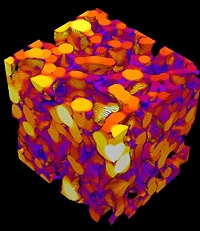A team from Imperial College’s bio-engineering department used X-ray microtomography to investigate how, for example, an elephant’s femur is able to maintain tensile strength and rigidity without adding extra weight.
The key lies in a network of trabecula (Latin for ‘small beam’), which form specialised tissues at the ends of load-bearing bones, where they act as mechanical struts.

Prior to the study it was not known if, or how, the geometry of trabeculae varied, or scaled up, depending on the size of the animal.
The team found that while the overall amount of bone per unit volume stayed roughly constant, the trabeculae in larger animals were thicker, further apart and less numerous. This seems to allow animals such as elephants to support their heavier load without the need for thicker and denser bones — saving valuable energy in the process.
‘We can learn a lot from nature, such as how nature develops these strong, lightweight structures. We could adopt this in design — it could inform how people develop structural foams,’ said project investigator Dr Sandra Shefelbine of Imperial.
She said it was still unclear whether the larger animals were born with this modified bone geometry or if it developed as they grew in response to an increasing load.
‘Bone is very responsive — for example, astronauts lose bone because they’re not loading it, so it could be that elephants have a much higher load on their bone so that bone then responds by building this particular structure,’ Shefelbine said.
So as well as informing the design of strong, lightweight materials, the research could also help with so-called ‘smart materials’, which can change their properties based on the conditions they are under — something of a long-term goal for engineers.
The team also developed an open source computer program called BoneJ that can make informed predictions about structure and performance.
‘The power of the computational model is you can start to predict what loads would be and how the bone might respond to that load. Some fossils have preserved trabeculae, which is pretty exciting as we can deduce the mass of an animal, the way the animal walked and so on,’ Shefelbine said.
As well as having potential applications in material science and palaeontology, the work is also relevant to human health, since defects in trabeculae can lead to conditions such as osteoporosis.
‘What happens in osteoporosis is you lose these trabeculae. So [the project] could help us understand what we are trying to fix — do we want to build more trabeculae or just strengthen the ones that are there?’ Shefelbine said.





Swiss geoengineering start-up targets methane removal
No mention whatsoever about the effect of increased methane levels/iron chloride in the ocean on the pH and chemical properties of the ocean - are we...